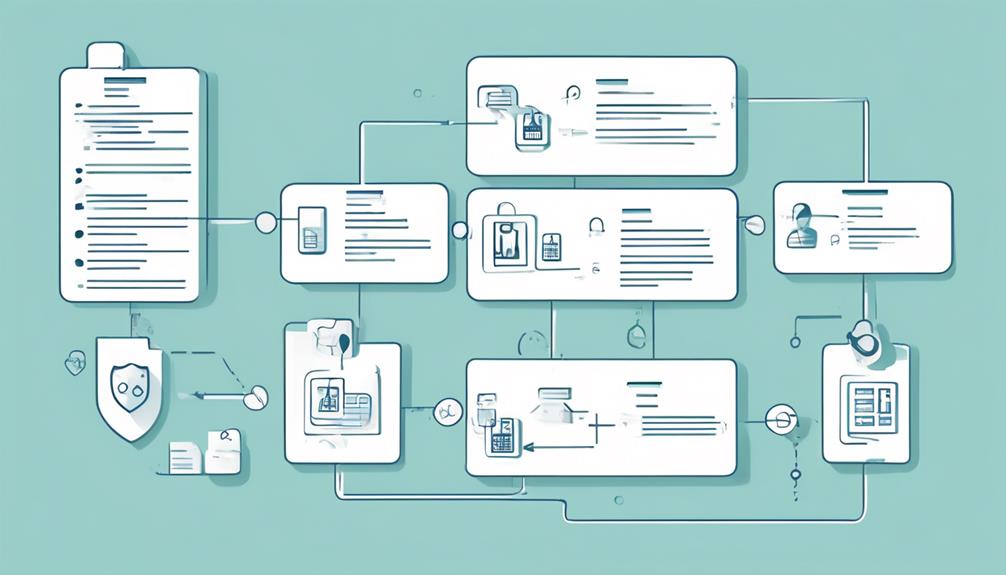You might be thinking that ensuring legal compliance with BS7858 vetting standards could be a complex and time-consuming task, especially for organizations with diverse security requirements.
However, by following a structured step-by-step approach outlined in this guide, you can navigate through the intricacies of the vetting process efficiently and effectively.
Understanding the nuances of required information gathering, data verification procedures, risk assessments, reporting guidelines, integration of screening technologies, continuous monitoring practices, and staff preparation can set you on the path to achieving robust legal compliance.
The importance of each step in this process cannot be underestimated, as it forms the foundation for safeguarding your organization's security protocols and upholding industry standards.
Required Information Gathering
When beginning the BS7858 vetting process, gathering the required information is a critical first step to ensure accurate data verification and conduct a thorough risk assessment.
The accuracy of the vetting process hinges on the quality of the information collected. By meticulously gathering all necessary data upfront, you lay a solid foundation for the subsequent stages of the vetting process. This includes details such as employment history, references, and personal information.
Ensuring the accuracy of this information is paramount to the success of the vetting process. It forms the basis on which further assessments will be made, influencing the overall outcome of the vetting process. Inaccuracies or missing information can lead to delays, inconsistencies, or even jeopardize the integrity of the vetting process.
Therefore, dedicating time and attention to gathering the required information diligently is crucial for a thorough and effective BS7858 vetting process.
Data Verification Process
To ensure the accuracy and integrity of the BS7858 vetting process, the next crucial step after gathering required information is the data verification process. This step is vital as it involves confirming the accuracy of the provided information and documentation.
By verifying the data, you help prevent delays and ensure the trustworthiness of security personnel. The verification process may require gathering and validating various personal and professional data to ensure its authenticity.
Accuracy verification is essential for maintaining the integrity of the screening process, as any inaccuracies could compromise the security measures in place. Conducting a thorough data verification process not only ensures compliance with BS7858 standards but also contributes to creating a reliable and secure work environment.
Risk Assessment Procedures
Implementing thorough risk assessment procedures is essential for safeguarding workplace safety, reducing employee turnover, protecting the company's reputation, ensuring regulatory compliance, and minimizing the risk of negligent hiring lawsuits.
To effectively conduct risk assessments, consider the following:
- Workplace Safety: Identify potential hazards and implement measures to mitigate risks, ensuring a safe working environment for all employees.
- Employee Turnover: Addressing risks proactively can lead to a more stable work environment, reducing turnover rates and promoting employee retention.
- Company Reputation: By assessing risks and taking preventive actions, you demonstrate a commitment to excellence, enhancing your company's reputation.
- Regulatory Compliance: Adhering to risk assessment procedures helps ensure that your company meets legal requirements, avoiding penalties and legal issues.
Reporting Guidelines
To ensure thorough vetting procedures, maintaining clear and comprehensive reporting guidelines is vital for documenting vetting results effectively and ensuring transparency in the process. These guidelines play a critical role in providing detailed and concise reports on the outcomes of vetting activities.
By following established reporting protocols, you can ensure that all relevant information is captured accurately and communicated efficiently. Consistency in reporting is facilitated through these guidelines, enabling comparability across various vetting cases.
Adhering to reporting guidelines isn't only a best practice but also a legal requirement for maintaining transparency and compliance with vetting standards like BS7858. Proper reporting practices contribute significantly to informed decision-making by stakeholders involved in the vetting process.
Integration of Screening Technologies
Enhancing vetting procedures through the integration of cutting-edge screening technologies is a pivotal aspect of ensuring thorough background checks. By incorporating advanced screening technologies into the BS7858 vetting process, you can significantly improve the efficiency and effectiveness of your screening efforts. Here are some key points to consider:
- Biometric Authentication: Implementing biometric authentication methods can enhance the accuracy and security of the screening process.
- Artificial Intelligence: Utilizing artificial intelligence in screening can help in conducting more thorough and efficient vetting, saving time and resources.
- Continuous Monitoring: Embracing technology for continuous monitoring of employees can keep you informed of any changes in their background or behavior.
- Social Media Screening: Integrating social media screening tools is essential as social media presence can provide valuable insights into an individual's character and behavior.
Continuous Monitoring Practices
Continuous monitoring of employees ensures ongoing awareness of any changes in their background or behavior that may impact their suitability for their role. By conducting regular checks on criminal records, credit history, and other pertinent information, organizations can promptly address any emerging concerns regarding employee suitability. This proactive approach to continuous monitoring helps in identifying and mitigating potential risks that employees may pose over time.
Not only does this practice aid in maintaining compliance with industry standards and regulations, but it also plays a crucial role in enhancing overall workplace safety. By staying vigilant through continuous monitoring, organizations can effectively safeguard themselves against insider threats and ensure a secure working environment for all staff members.
Embracing continuous monitoring practices is key to fostering a culture of ongoing risk management and upholding the integrity and security of the organization.
Staff Preparation for Vetting
As you prepare your staff for vetting, ensure they're briefed on the process and understand the importance of providing accurate information. It's crucial to have all documents in order and to emphasize the significance of honesty throughout the screening process.
Here are some key points to focus on when preparing your staff:
- Briefing: Provide a detailed overview of the vetting process and what's expected from them.
- Document Preparation: Double-check that all necessary documents are organized and up to date for submission.
- Understanding the Importance: Stress the importance of providing accurate and truthful information to prevent any delays or issues during the vetting process.
- Emphasize Cooperation: Encourage staff members to cooperate fully with the vetting process to ensure it runs smoothly and efficiently.
Ensuring your staff is well-prepared and informed won't only streamline the vetting process but also demonstrate your commitment to compliance and security standards.
Conclusion
In conclusion, by following this step-by-step guide to BS7858 vetting legal compliance, you can ensure that your organization's security team meets stringent screening standards.
By gathering required information, verifying data, conducting risk assessments, and integrating screening technologies, you can streamline the process, enhance regulatory compliance, and mitigate risks.
By preparing your staff for the vetting process and implementing continuous monitoring practices, you can strengthen your company's reputation and commitment to employee well-being.



